- Home
- Deceptions
- Solar
- Thermal Audit
- Ventilation
- Sensors
- Governance
- Environment
- Reference
- Contact
- News
Power Factor Correction Scam Review
Power Factor Correction for reducing electric power bills of residential customers (home owners) is a scam. At most, each unit is worth a few cents as an investment. Power factor correction does make sense for some commercial / industrial customers or for rare situations where you pay for current (amps) or are connected to a gas/diesel generator.
if you are reading this because you saw a nice video on YouTube showing how these devices save money, watch again and you will see them showing you the current (amps) being reduced when the power factor device is switched on. This is correct, except that you are billed in kilowatt hours (kWh) not amps. If they set their meters to show kWh instead of amps, there would have been no change at all and it would have become the perfect demonstration of how these devices are useless for reducing power bills.
The KVAR Power Factor Optimizer from Save Energy LLC is a typical example of this scam. Others to look out for are KVAR Energy Saving Systems, KVAR EC, KVAR Energy Controller KEC PU1200, Nevvus Powerguard, Power-Save 1200, Power Saver HOME, Kilowatt Nanny, PowerwoRx-e3, Power Saver Enersonic and SurgeXpro.
Update: There is now a definitive debunking from a source you should trust; the National Institute of Standards and Technology (NIST), an agency of the U.S. Commerce Department. NIST Team Demystifies Utility of Power Factor Correction Devices and the much more detailed technical report NIST Technical Note 1654, Regarding Electric Energy Savings, Power Factors, and Carbon Footprints: A Primer.
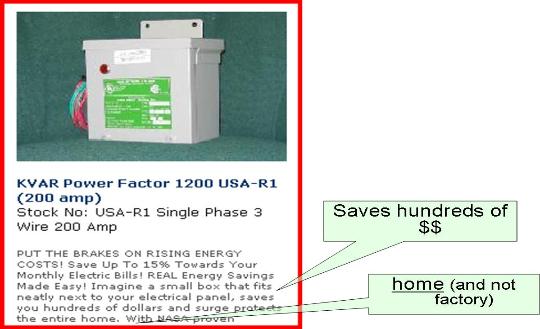
The power factor of a toaster or ordinary incandescent light bulb is 1 (one). Devices with coils or capacitors (like pumps, fans and florescent light bulb ballasts) have power factors less than one. When the power factor is less than 1, the current and voltage are out of phase. This is due to energy being stored and released into inductors (motor coil) or capacitors on every AC cycle (usually 50 or 60 times per second). Graphically, the voltage and current used by your toaster would looks like this.
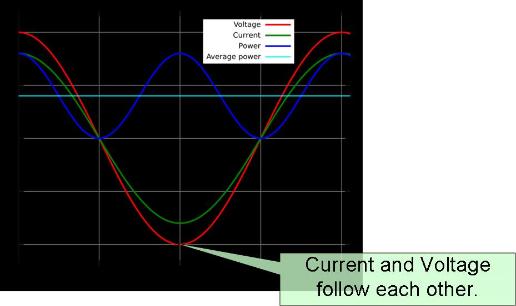
The meter below is measuring the power factor of a small aquarium pump, and is showing a power factor of 0.28. If you were to graph the voltage and current used by the pump, you would see that the red and green lines (the voltage and current) are shifted relative to each other compared to the graph above, like this:
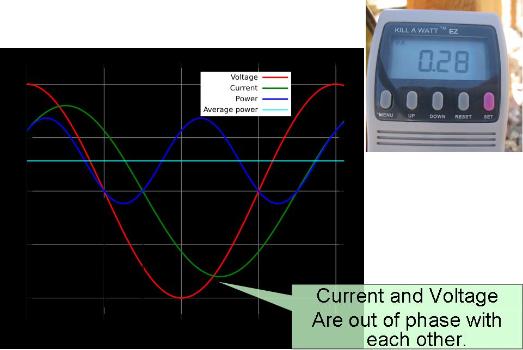
There are three terms you will encounter when dealing with alternating (AC) power (as opposed to DC or batteries). The first is the kilowatt, abbreviated kW, and it represents real power. Real power can perform work. Power company utility meters on the side of your house measure this quantity and charge you for it.
The second term is reactive power, and it is measured in KVAR which is short for kilo volt amp reactive. Unlike kW, it cannot perform work. Residential customers do not pay for KVAR, and utility meters on houses do not record it.
The third term is apparent power, referred to as KVA. If you hook up two multimeters to measure current and voltage and then multiply the readings together, you get apparent power in volt amps, or VA. To distinguish it from real power, VA is used instead of W.
In the special case of resistive loads (like baseboard heaters or an electric stove element or old fashioned incandescent light bulb), the current and voltage are in phase. Real power equals apparent power, and reactive power equals zero.
These three quantities are related by the Power Triangle.
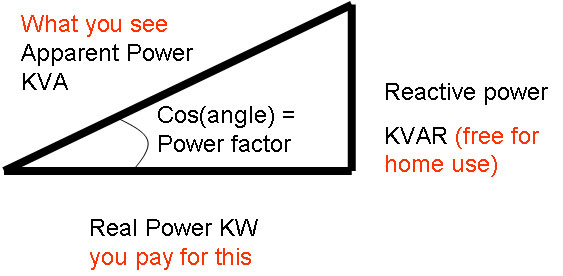
The cosine of the angle above is also equal to KW ÷ KVA so you can think of the power factor as the ratio of real power to what you measure with a volt and amp meter (apparent power). If they are equal, then your power factor is one.
Reactive power is not a problem for a motor and is required for its operation. It is a problem for the electric utility company when they charge for KW only. If two customers both use the same amount of real energy but one has a power factor of 0.5, then that customer also draws double the current. This increased current requires the power company to use larger transformers, wiring and related equipment. To recover these costs, industrial customers are charged a price premium for low power factors. Residential customers (homes) in North America are never charged extra.
While power factor correction is useful for many industrial customers who use large amounts of power, it is a deception when marketed to home owners (often for several hundred dollars installed) as a way to save money on their electric bill.
What happens when you install it?
The diagram below shows the result of correcting the power factor. The air conditioner (which has a large compressor motor) is still consuming reactive power but it is being supplied by a nearby capacitor (which is what is in those "KVAR" boxes). If you were to mount it at the air conditioner and switch it on with the air conditioner plus you sized the capacitor perfectly, then there would be no reactive power on the line going back to the fuse panel. If the wire between your fuse panel is very long and undersized, reducing the current would result in it running cooler and having a higher voltage at the air conditioner. These savings due to cooler wiring is minimal.
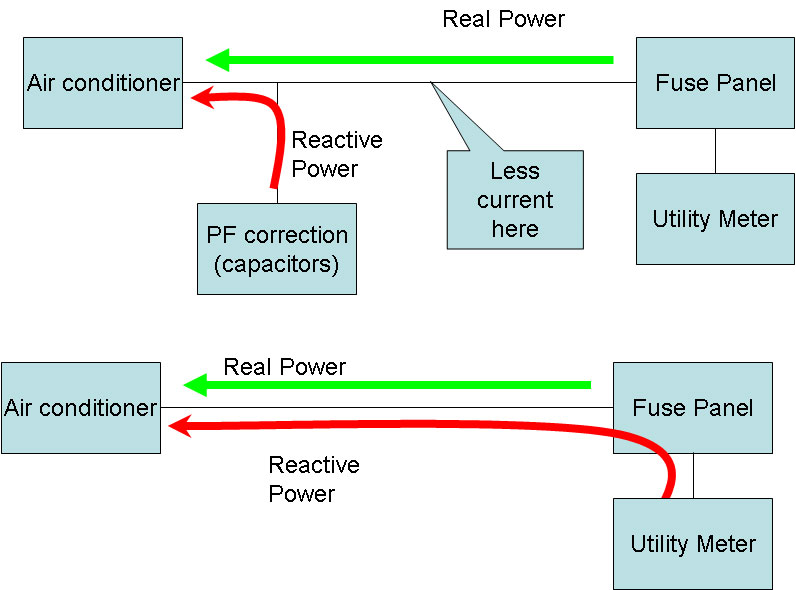
A further complication is that if you install the "KVAR" unit at the fuse panel, it does nothing for the heat losses except for the two feet of huge wire between the fuse panel and the utility meter. Many KVAR units are marketed as boxes that you install at a single location. If your power factor box is too large, then it will be providing reactive power for something else, perhaps your neighbor.
In summary, there are multiple problems:
- The KVAR unit should be mounted near the motor and switched with the motor. This means you need switches and multiple units. It makes far more sense for modern appliances to be designed so that the power factor is close to one, and in fact, this is where the industry is headed.
- The KVAR needs to be sized perfectly to balance the inductive loads. Since your motors cycle on and off and you don't use the air conditioner in the winter, there is no way to get it sized properly unless you have something to monitor the line and switch it on and off capacity (capacitors) as necessary.
- Adding a capacitor can increase the line voltage to dangerous levels because it interacts with the incoming power transmission lines.
- Adding a capacitor to a line that has harmonic frequencies (created by some electronic equipment) on it can result in unwanted resonance and high currents.
If you are an Industrial customer, this is not a problem. You can hire an engineer to do a power study, look at issues like harmonic distortion, voltage sags, equipment location, capacity of existing wiring, potential locations for the correction equipment, determine how many units are required and the values of the capacitors, and then develop a potential solution. The study will determine if the project makes financial sense -- even for industrial customers who get a price break for good power factor, it is not always economical. The result will be a custom solution, not an off-the-shelf box and it will be expensive.
Here is one that is clearly being marketed to households and therefore a scam:
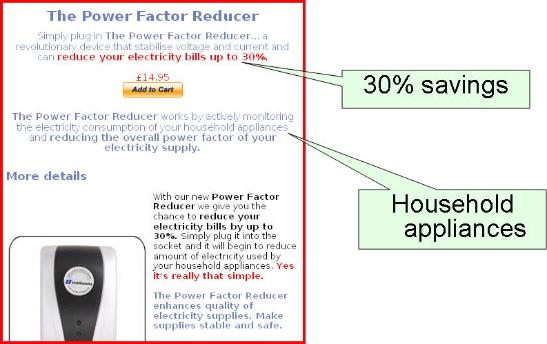
For a more comprehensive review of the subject, go to Wikipedia - Power Factor Correction.
This article is excellent: Lessons In Electric Circuits -- Volume II Power Factor
Do Power Factor Correction Devices (sometimes called Amp Reduction Units or KVAR) really save money? Can they earn the ENERGY STAR label?
ENERGY STAR does not qualify any Power Factor Correction Devices. Please send us an email at logomisuse@energystar.gov if you see one that claims to be ENERGY STAR certified.
Power Factor Correction Devices claim to reduce residential energy bills and to prolong the productive life cycles of motors and appliances by reducing the reactive power (kVAR) that is needed from the electric utility.
We have not seen any data that proves these types of products for residential use accomplish what they claim. Power factor correction devices improve power quality but do not generally improve energy efficiency (meaning they won't reduce your energy bill). There are several reasons why their energy efficiency claims could be exaggerated. First, residential customers are not charged for KVA-hour usage, but by kilowatt-hour usage. This means that any savings in energy demand will not directly result in lowering a residential user's utility bill. Second, the only potential for real power savings would occur if the product were only put in the circuit while a reactive load (such as a motor) were running, and taken out of the circuit when the motor is not running. This is impractical, given that there are several motors in a typical home that can come on at any time (refrigerator, air conditioner, HVAC blower, vacuum cleaner, etc.), but the unit itself is intended for permanent, unattended connection near the house breaker panel.
For commercial facilities, power factor correction will rarely be cost-effective based on energy savings alone. The bulk of cost savings power factor correction can offer is in the form of avoided utility charges for low power factor. Energy savings are usually below 1% and always below 3% of load, the higher percentage occurring where motors are a large fraction of the overall load of a facility. Energy savings alone do not make an installation cost effective.
End of Quote
Still not convinced?
One of the more surprising comments I have received lately was that this kind of analysis is "Rubbish" or that it doesn't address the "fact" that some acquaintance of theirs is saving money using a power factor correction device. This is unfortunate. I don't dispute that you may have seen a reduced power bill, just the "fact" that this reduction is due to the "device" and not other factors that were overlooked.
Electrical theory is not some "theory" that might or might not be true. This is an area that has been well understood for more than a century and concepts like resistance, impedance and reactive current are accepted as reality -- something which you ignore at your peril. Even if future understandings of particle physics were to give us new insights to old laws -- these old laws are for all practical purposes, perfect for predicting an outcome in household situations.
Despite this, people install devices like this and become convinced that any reduction in their power bill is due to the device. Remember that if you want to test something like this with the intention of proving that it defies our current engineering knowledge, you are going to have to use calibrated test equipment and carry out carefully controlled experiments. The temperature (degree days) vary greatly from year to year, habits change (longer or shorter showers) and a host of other things will vary your monthly power bills significantly from any chosen month from one year to the next. Even thinking about your energy saving device causes behavior changes -- like turning off lights when you leave a room, running the water less, etc. Therefore, your monthly power bill is in no way a controlled experiment, and the savings you are hoping to measure are very small compared to regular variations. Comparing power bills is useful, but only verifies significant savings such as switching from electricity to natural gas, changing high flow to low flow shower heads or other major changes.
If your experiments lead you to conclude that you actually save significant percentages of power using one of these devices, you need to re-evaluate your controls. Since these results would be violating the laws of physics, nobody will believe them unless they can repeat them. If nobody can duplicate your results (which is extremely likely) then you must re-evaluate your experiment. Finally, very few people who can set up a proper experiment are going to be willing to spend their hard earned money to purchase a device and then spend time conducting an experiment to prove that their purchase was a waste of money. And even if they did, would you believe them?
-- January 2009 --
I will post any feedback received below. I have left out names and e-mail addresses (unless the authors request it) so that they don't get spammed.
Great analysis. Particularly your point about connecting the power factor correction capacitor(s) directly across the inductive motor so that they are only in the circuit when the motor is switched on. Now, multiply that exercise for every inductive motor in the home -the compressor motors for the ac and the refrigerator(s), dishwasher, hot water circulating pump(s), etc. Every one of these appliances needs its own capacitor. It thus becomes obvious why these devices are not even remotely cost effective for residential applications. And certainly not in the way the manufacturers recommend that they be installed, that is, permanently connecting them at the main panel. Doing that drags the power factor capacitive when the inductive motors are off and could create some real problems with ringing voltages.
Thank you so much for your article on the PFC devices. I have been an electrician for 30 years and worked for electrical engineering firms for 10 of those years, specializing in power quality and diagnostic testing. I was researching for a friend as I've run across these PFC scams before. I passed your link on to him and he just saved a lot of money by not being duped. Very well done! -- Mike Cole
First let me say that your article on power factor is the best I have found. Second, I am an electrical engineer - electronics not power - but I do remember power factor calculations from Freshman circuit theory. I agree and am convinced that as an energy consumer getting one of these KVAR units is a waste of money but I was wondering if they might be useful as an energy producer. In other words we know that power companies do save money by power factor correction in their distribution grid. Since I am now a very small power producer with my PV system can a KVAR unit help me improve the delivery of the power that I am producing? I expect the answer is no but I have not found this specific question answered anywhere yet. -- Burt Wagner
Hello Burt,
The answer is yes. There are a few situations where it might help you. Power companies have to use larger diameter wiring and bigger transformers to carry the reactive power, so they encourage factories with low power factors to improve it by demanding penalties. This reduces their infrastructure costs.
You PV system has similar issues. You inverter is very expensive and is rated in VA (volt amps). The same goes for a computer uninterruptable power supply. A Tripplite brand 1200W UPS is rated as 1500VA. The 1500VA is the real limit. The 1200W assumes a 0.80 power factor. If you were plugging in a toaster instead, it could support 1500W.
So, if you connect a large power factor correction unit to your PV systems inverter, you would do the following: 1) accomplish nothing in terms of resistive losses -- for that you would have had to connect the PF correction directly to things like the washing machine 2) reduce the size of the inverter required. The latter is analogous to what the power company sees -- increase the power factor close to 1.0, eliminate the reactive power and save money by reducing the size and capacity of equipment. For you, power delivery is about the batteries, cables to the inverter, inverter, charge controller etc. For them it is the size of wire on the poles and the size of the pole transformers, fuse capacities, size of utility poles to support the weight etc.
Even if the existing PV inverter is paid for, a power factor of 1.0 should allow it to run cooler and be less likely to overload when you have too many appliances on. You would probably want to get a PF meter and verify the real power factor. There are some cheap units for 100V that you can plug in the wall, but the best thing would be to borrow something like this: Extech Power Analyzer. If you have an expensive inverter, perhaps these measurements are built in. It might be difficult to prove if you would save money in premature inverter failures, but it would certainly be an interesting question to answer. Does a $3000 inverter run at half capacity last longer, perhaps it has internal fans that don't start up until it approaches 80% capacity etc.If you decide to experiment with this, please let me know how it works out.
Here is an analogy from Burt that is rather creative:I did one more search on power factor correction and finally found a non-technical analogy that I can use to explain this whole thing to the person trying to sell it to me:
Think of a bag of potato chips.
You open the bag and it just doesn't seem full enough.
Then you look at the label and it says it's packaged by weight, not by volume.
Yes you only eat the chips. The extra air in the bag is not a scam. It's just an unavoidable and normal part of packaging and delivery.
The ratio of weight to volume would be like "power factor" of packaging and delivery.
Utility power is like that bag of potato chips.
"Real" power (watts) is like the chips. Real power is the only power your motor (or fridge, or hair dryer, or TV, or light fixture...) can "eat."
The "imaginary" or "reactive" power is just "air" in the wires, an unavoidable part of what it takes to deliver the watts.
Plugging something into a receptacle to reduce power factor is like "vacuum packing" the bag. You get more "chips" (watts) in the same size "bag" (volt-amps).
The most common device for "vacuum packing" power is a capacitor.
The most common thing that blows more air into the bag is a motor.
So connecting a capacitor in parallel with a motor helps deliver more chips per bag (watts per volt-amp) to that motor.
By getting rid of the air in the bag you do not save any money since you are only being charged for the chips!
BUT the power company does care about the air in the bags since the larger bags require larger "trucks" to deliver the bags.
What do you think? I think this just may convince him. -- Burt
comments = I just reviewed your article on Power Factor Correction. I agree with your conclusions BUT I think other factors might be resulting in the savings some people claim.
I would respectively suggest that all electricity meters are not measuring ONLY real power. The very old meters certainly tried to do this but with some newer electronic meters I'm not so sure.
The most popular E-Meter chips are from Analog Devices, one of the latest is the ADE7757. Notice that PF error is quoted as a spec for this chip but is not mentioned in earlier chips. However notice that Harmonic distortion is not a meter spec, nor is AC-Line Noise rejection.
http://www.analog.com/static/imported-files/application_notes/81462932AN679_a.pdfhttp://www.analog.com/static/imported-files/tech_articles/17011149511795ANALOG_PAGE_68-71.pdf
Also notice that power is recorded as a pulse (usually optically isolated). This suggests that any unusual Power line condition that results in a reading error can only cause a meter Increment (there is NO Meter decrement function), so unlike old meters there is no way to make the meter run backwards. Even if you actually source power such as from a solar cell array.
OK so what are the PFC caps doing
- AC Line filtering right at the meter (removes aliasing, important for very high Harmonic distortion loads, such as a load with lots of PC's)
- AC couples Line and Neutral, so large transient voltages on the Line are not seen by the meter chip (become "common mode")(kind of like PSRR / CMRR system spec, (remember meter only increments)
- Filtering out-of-band AC signals, Broadband PLC modems, Narrowband PLC modems, X10 signals.
BTW: although Analog Devices certainly knows what they are doing, many second tier semiconductor companies, that also try to do these meter chips, really don't have a clue, result all measurement errors are extra "real power" for the consumer
If my assumptions are correct than the correct system location for the PFC cap is directly across the meter, not at the load.
How can the measurement error occur:
Most E-meter's use an ADC (analog to digital converter) based on Audio Sigma Delta technology. If you want the power of the meter chip to be very low than you reduce the "over sample ratio" (If all signal content was at 50Hz (line freq) than in theory a second order sigma delta with a 10 times over sample ratio (sample frequency = 500Hz) would be adequate. Unfortunately 500Hz is only the 10th harmonic so a LOT of (switched mode power supplies) SMPS especially under light load, will consume a lot of their power at the 10th harmonic of the Line frequency (60Hz in the US), this could be completely misread by a low sampling frequency ADC.
For Narrow Band PLC (auto matic meter reading) the signal on the AC-line can be as high as 10Vp-p typically around 140Khz this is WAY out of band and needs to be removed before the ADC by an RC filter, many cheaper systems failed to use such a filter. As a result the Sigma Delta will often lock to this as some sort of "residual clock" remember these meter chips are typically a spin-off from Audio converters (In the case of Audio, aliasing to DC the residual Clock,from some cheap DAC, is a very good feature to have) In the case of a E-Meter chip it could mean a +-5% error.
Most of the problems I have mentioned would be significantly reduced by a nice big cap right across the E-meter, hence my assumption that this is in reality what the PFC caps are doing.
note: On re-reading the post I noticed that it seems to imply that Analog Devices is complicit in some sort of conspiracy against consumers, which I do not believe, at all.
Updates:
I have removed comments I had earlier from promoters of these scams because it became apparent that their arguments were adding nothing to the discussion and making this article more tedious to read. The arguments are always the same, namely a) my bills are lower, why don't you want to see them b) it's NASA approved c) recommended by the governments and universities but without links d) I don't know what I am talking about e) various promotional press releases and when that doesn't work, Ad hominem attacks.
I have contacted NASA for their opinion and position on the so called "NASA approved" claim, based on what looks like an old interoffice memorandum and will post their reply here when I get one.
I also encourage everyone to report these scams using the FTC so that they can track them. Unless many people complain, nothing will be done to crack down on types of scams. A good way to approach it is to quote the DOE/ENERGYSTAR site "We have not seen any data that proves these types of products for residential use accomplish what they claim. Power factor correction devices improve power quality but do not generally improve energy efficiency (meaning they won't reduce your energy bill)." and then point out that these people are claiming 25-30% savings for residential (not commercial) customers. Reviewers at the FTC will probably take the Environmental Protection Agency and Department of Energy as a trusted source even if they don't understand the technology. The gulf between the governmental source "they won't reduce your energy bill" and the scammer's "Save 30% on your electric bill" will be a clear indication of fraud worthy of investigation.
Additionally, anytime you see one of these products claiming to be ENERGYSTAR qualified or displaying the logo, please consider this: "ENERGY STAR does not qualify any Power Factor Correction Devices. Please send us an email at logomisuse@energystar.gov if you see one that claims to be ENERGY STAR certified. "
